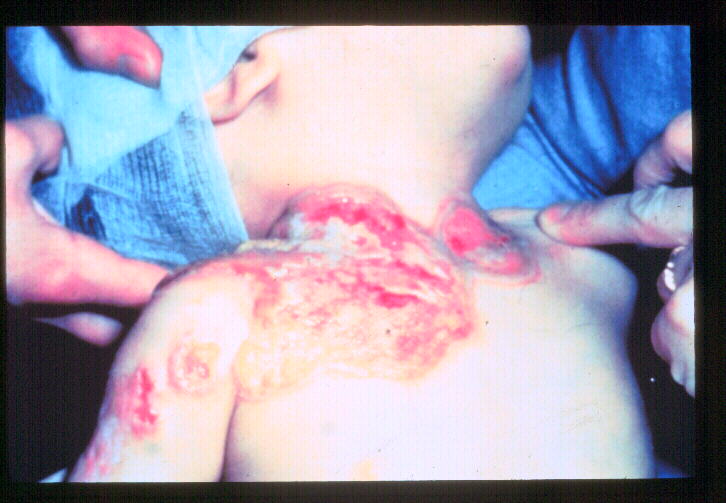VACCINIA VIRUS
Vaccinia virus is a big mystery in virology. It is not known whether vaccinia virus is the product of genetic recombination, or if it is a species derived from cowpox virus or variola virus by prolonged serial passage, or if it is the living representative of a now extinct virus. Vaccinia virus was used for smallpox vaccination via inoculation into the superficial layers of the skin of the upper arm. However, with the eradication of smallpox, routine vaccination with vaccinia virus has ceased. Recent interest in vaccinia has focused on its possible usage as a vector for immunization against other viruses.
Much less virulent strains than those used for vaccination against smallpox are being developed for use as vectors, in hopes of reducing the likelihood of the development of serious complications previously seen with smallpox vaccination. In this page, you will learn more about the very rare, though serious, complications that arose as a result of smallpox vaccination.
Primary response to vaccination
Four to five days following vaccination with vaccinia virus, a papule appeared at the site of vaccination. Two or three days later the papular lesion became vesicular, growing until it reached its maximum diameter on the 9th or 10th day. During this time, the draining lymph nodes of the axial were enlarged and tender. Many patients also presented a mild fever. The lesion dried from the center outward, and the brown scab fell off after about three weeks, leaving a scar- a mark by which previous vaccinees could be recognized.
Complications of Vaccination
Progressive vaccinia (vaccinia necrosum)- Progressive vaccinia is a severe, potentially fatal illness characterized by progressive necrosis at the site of vaccination. This occurred only in immunocompromised individuals with deficiencies in their cell-mediated immune system. There were only about 1.6 cases of progressive vaccinia per million vaccinations reported. See picture below for clinical manifestation of progressive vaccinia.

Eczema vaccinatum- This occurred only in persons who suffered from eczema. Unvaccinated contact with a vaccinated individual was the usual mode of transmission.
In a national survey in the United States conducted after smallpox had been eliminated, there were 66 cases, with no deaths, among 14.5 million vaccinees.
Generalized vaccinia- Generalized vaccinia was characterized by a vesicular rash that sometimes covered the entire body. This usually occurred 6 to 9 days after vaccination.
The lesions usually resembled the initial lesion found at the inoculation site, but they sometimes varied in size. Generalized vaccinia was not associated with immunodeficiency. The rash was usually self-limiting and thus, little or no therapy was administered. There were about 23.4 cases per million vaccinees.
Postvaccinial encephalitis- Neurological complications were the most serious ones that occurred from vaccination with vaccinia virus. Postvaccinal encephalitis usually occurred in patients over the age of two. The case fatality rate was about 35% within a week of onset. In the United States, there were 12 cases, of which one resulted in death, among the 13 million vaccinees.
Accidental infection- Accidental infection of some part of the body away from the inoculation site was the most common complication that arose from vaccination with vaccinia. Ocular vaccinia was a common manifestation of accidental infection.